Cooling JAGUAR X308 1998 2.G Owner's Manual
[x] Cancel search | Manufacturer: JAGUAR, Model Year: 1998, Model line: X308, Model: JAGUAR X308 1998 2.GPages: 2490, PDF Size: 69.81 MB
Page 830 of 2490

Engine - Upper Oil Pan3.2L NA V8 - AJ26
In-vehicle Repair
Removal
Special Tool(s)
Installer/remover, Oil Filter
303-752
1. Disconnect the batt ery ground cable.
Remove the battery cover.
2. Open the engine compartment and fit paintwork protection
sheets.
3. Set the engine compartment cover to the service access
position.
4. Remove the timing cover and al l associated components, as
detailed in Operation 12.65.01.
5. Remove both front wheel and tyre assemblies. Refer to
Operation 74.20.05.
6. Remove the undertray. Re fer to Operation 76.22.90.
7. Remove the two bolts which secu re the generator cooling duct
to the oil pan body and remove the duct.
8. Remove the front cross member for access. Refer to Operation
76.10.05.
9. Drain the engine oil.
1. Position the waste oil bowser.
2. Remove the drain plug from the oil pan and drain the engine oil.
Fit a new sealing washer to the drain plug.
Page 838 of 2490

16. Install the front cr ossmember. Refer to Operation 76.10.05.
17. Position the generator cooling duct to the oil pan body and
install the two bolts.
18. Install the undert ray. Refer to Operation 76.22.90.
19. Install both front wheel and tyre assemblies. Refer to
Operation 74.20.05.
20. Install the timing cover and al l associated components, as
detailed in Operation 12.65.01.
21. NOTE: When the engine is star ted from cold and run for a
short period only, before being swit ched off, a quantity of oil will
be 'hung up' within the engine because it is not up to operating
temperature.
Should the oil level subsequently be topped-up, the level could
become too high, causing oil burning.
Typically, 0.875 L is hung up.
Refill the engine with the correct specification engine oil.
22. Connect the battery and in stall the battery cover.
Refer to the Battery Reconnection Procedure 86.15.15.
23. Check the oil level and start th e engine. Check for leaks and
that the engine runs correctly.
24. Reposition the engine compartment cover and connect the
gas struts.
25. Remove the paintwork protection sheets and close the engine
compartment cover.
Page 839 of 2490

Engine - Upper Oil Pan4.0L NA V8 - AJ27, 4.0L
In-vehicle Repair
Removal
Special Tool(s)
Installer/remover, Oil Filter
303-752
1. Disconnect the batt ery ground cable.
Remove the battery cover.
2. Open the engine compartment and fit paintwork protection
sheets.
3. Set the engine compartment cover to the service access
position.
4. Remove the timing cover and al l associated components, as
detailed in Operation 12.65.01.
5. Remove both front wheel and tyre assemblies. Refer to
Operation 74.20.05.
6. Remove the undertray. Re fer to Operation 76.22.90.
7. Remove the two bolts which secu re the generator cooling duct
to the oil pan body and remove the duct.
8. Remove the front cross member for access. Refer to Operation
76.10.05.
9. Drain the engine oil.
1. Position the waste oil bowser.
2. Remove the drain plug from the oil pan and drain the engine oil.
Fit a new sealing washer to the drain plug.
Page 847 of 2490
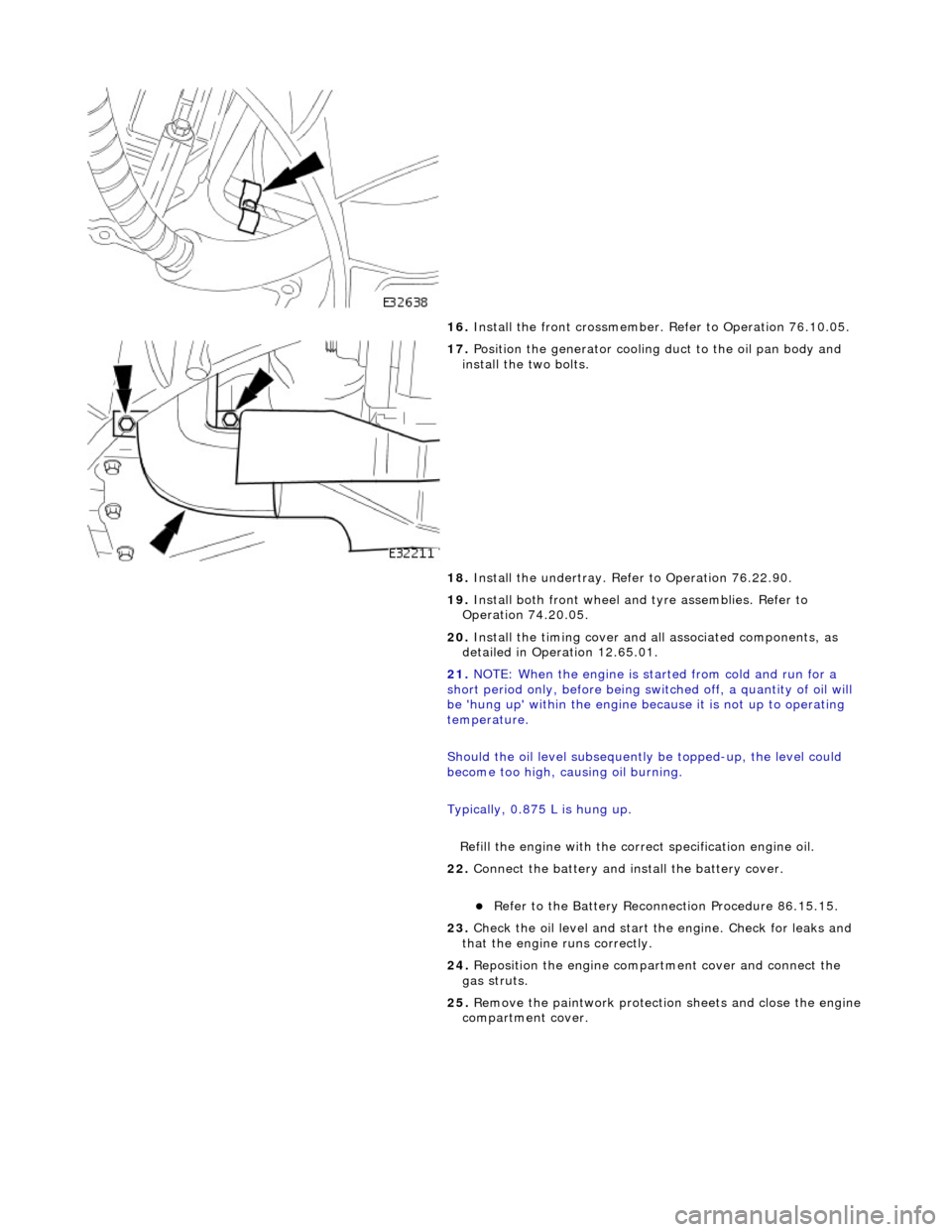
16. Install the front cr ossmember. Refer to Operation 76.10.05.
17. Position the generator cooling duct to the oil pan body and
install the two bolts.
18. Install the undert ray. Refer to Operation 76.22.90.
19. Install both front wheel and tyre assemblies. Refer to
Operation 74.20.05.
20. Install the timing cover and al l associated components, as
detailed in Operation 12.65.01.
21. NOTE: When the engine is star ted from cold and run for a
short period only, before being swit ched off, a quantity of oil will
be 'hung up' within the engine because it is not up to operating
temperature.
Should the oil level subsequently be topped-up, the level could
become too high, causing oil burning.
Typically, 0.875 L is hung up.
Refill the engine with the correct specification engine oil.
22. Connect the battery and in stall the battery cover.
Refer to the Battery Reconnection Procedure 86.15.15.
23. Check the oil level and start th e engine. Check for leaks and
that the engine runs correctly.
24. Reposition the engine compartment cover and connect the
gas struts.
25. Remove the paintwork protection sheets and close the engine
compartment cover.
Page 849 of 2490

12. Remove the undertray. Re fer to Operation 76.22.90.
13. Remove the two bolts which se cure the generator cooling
duct to the oil pan body and remove the duct.
14. Remove the front cross member for access. Refer to
Operation 76.10.05.
15. Drain the engine oil.
1. Position the waste oil bowser.
2. Remove the drain plug from the oil pan and drain the engine oil.
Fit a new sealing washer to the drain plug.
Wipe the drain plug and install it to the oil pan to prevent
oil dripping.
Move the oil bowser away from the vehicle.
16. Remove the oil pan.
1. Remove the eighteen bolt s which secure the oil pan
to the oil pan body.
2. Remove the oil pan.
3. Remove the gasket from the oil pan body assembly.
17. Disconnect the oil cooler pipes.
1. Remove the bolt which secures the oil cooler pipes.
2. Disconnect the oil cooler pipes from the oil pan body
assembly.
3. Remove and discard the O-ring seals from the pipes
and install blanking plugs to the pipes and unions.
18. NOTE: Place a suitable container underneath filter to prevent
oil spillage.
Page 857 of 2490

Install and tighten the lower securing bolts to 18-24 Nm.
Tighten the upper securing bolts to 18-24 Nm.
16. Position the transmission cooler pipes and the clamping
bracket. Install the bolt to secu re the clamp and tighten to 7-9
Nm.
17. Connect the oil cooler pipes to the oil pan body assembly
(vehicles with engine oil cooler).
1. Remove the blanking plugs and install new O-ring seals.
2. Connect the oil cooler pipes.
3. Install the clamp and bolt which secures the oil cooler pipes. Tighten to 18-24 Nm.
18. Install the front cr ossmember. Refer to Operation 76.10.05.
19. Position the generator cooling duct to the oil pan body and
install the two bolts.
20. Install the undert ray. Refer to Operation 76.22.90.
21. Install both front wheel and tyre assemblies. Refer to
Operation 74.20.05.
22. Install the timing cover and al l associated components, as
detailed in Operation 12.65.01. Do not refill the cooling system
at this stage.
Page 858 of 2490
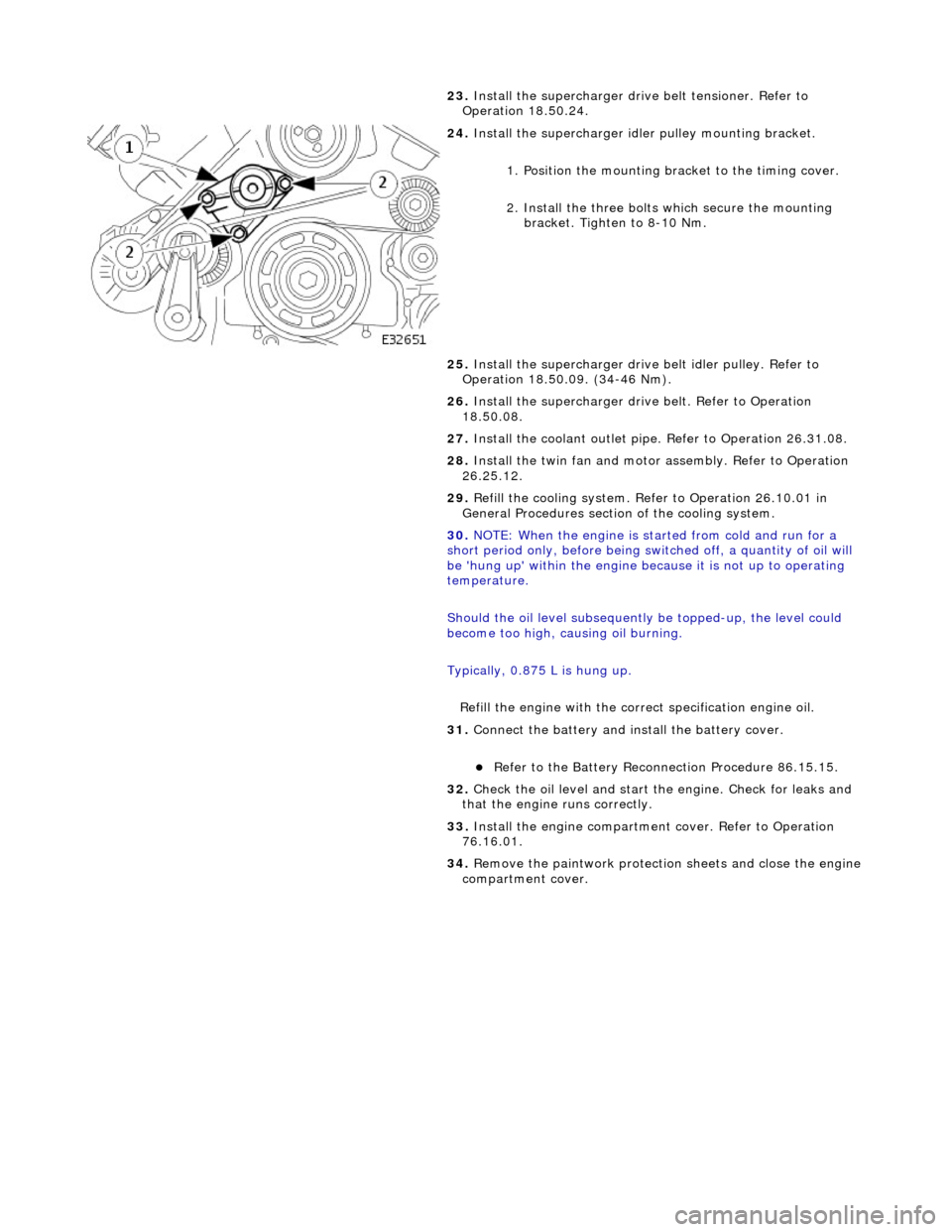
23.
Install the supercharger driv e belt tensioner. Refer to
Operation 18.50.24.
24. Install the supercharger idle r pulley mounting bracket.
1. Position the mounting bracket to the timing cover.
2. Install the three bolts which secure the mounting bracket. Tighten to 8-10 Nm.
25. Install the supercharger drive belt idler pulley. Refer to
Operation 18.50.09. (34-46 Nm).
26. Install the supercharger driv e belt. Refer to Operation
18.50.08.
27. Install the coolant outlet pipe. Refer to Operation 26.31.08.
28. Install the twin fan and motor assembly. Refer to Operation
26.25.12.
29. Refill the cooling system. Refer to Operation 26.10.01 in
General Procedures section of the cooling system.
30. NOTE: When the engine is star ted from cold and run for a
short period only, before being swit ched off, a quantity of oil will
be 'hung up' within the engine because it is not up to operating
temperature.
Should the oil level subsequently be topped-up, the level could
become too high, causing oil burning.
Typically, 0.875 L is hung up.
Refill the engine with the correct specification engine oil.
31. Connect the battery and in stall the battery cover.
Refer to the Battery Reconnection Procedure 86.15.15.
32. Check the oil level and start th e engine. Check for leaks and
that the engine runs correctly.
33. Install the engine compartmen t cover. Refer to Operation
76.16.01.
34. Remove the paintwork protection sheets and close the engine
compartment cover.
Page 897 of 2490
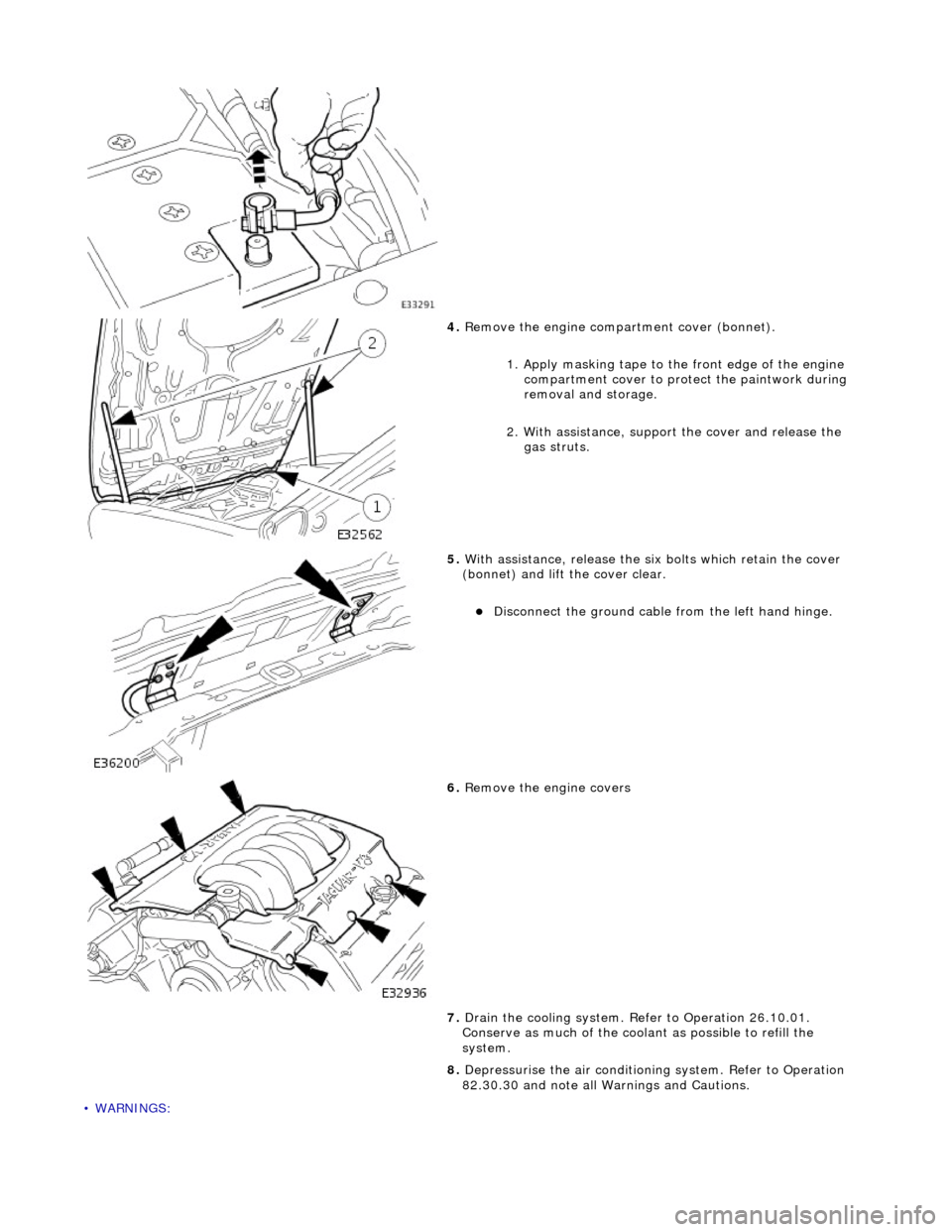
• WARNINGS:
4. Remove the engine compartment cover (bonnet).
1. Apply masking tape to th e front edge of the engine
compartment cover to protect the paintwork during
removal and storage.
2. With assistance, support the cover and release the
gas struts.
5. With assistance, release the six bolts which retain the cover
(bonnet) and lift the cover clear.
Disconnect the ground cable from the left hand hinge.
6. Remove the engine covers
7. Drain the cooling system. Refer to Operation 26.10.01.
Conserve as much of the coolant as possible to refill the
system.
8. Depressurise the air conditioni ng system. Refer to Operation
82.30.30 and note all Wa rnings and Cautions.
Page 922 of 2490
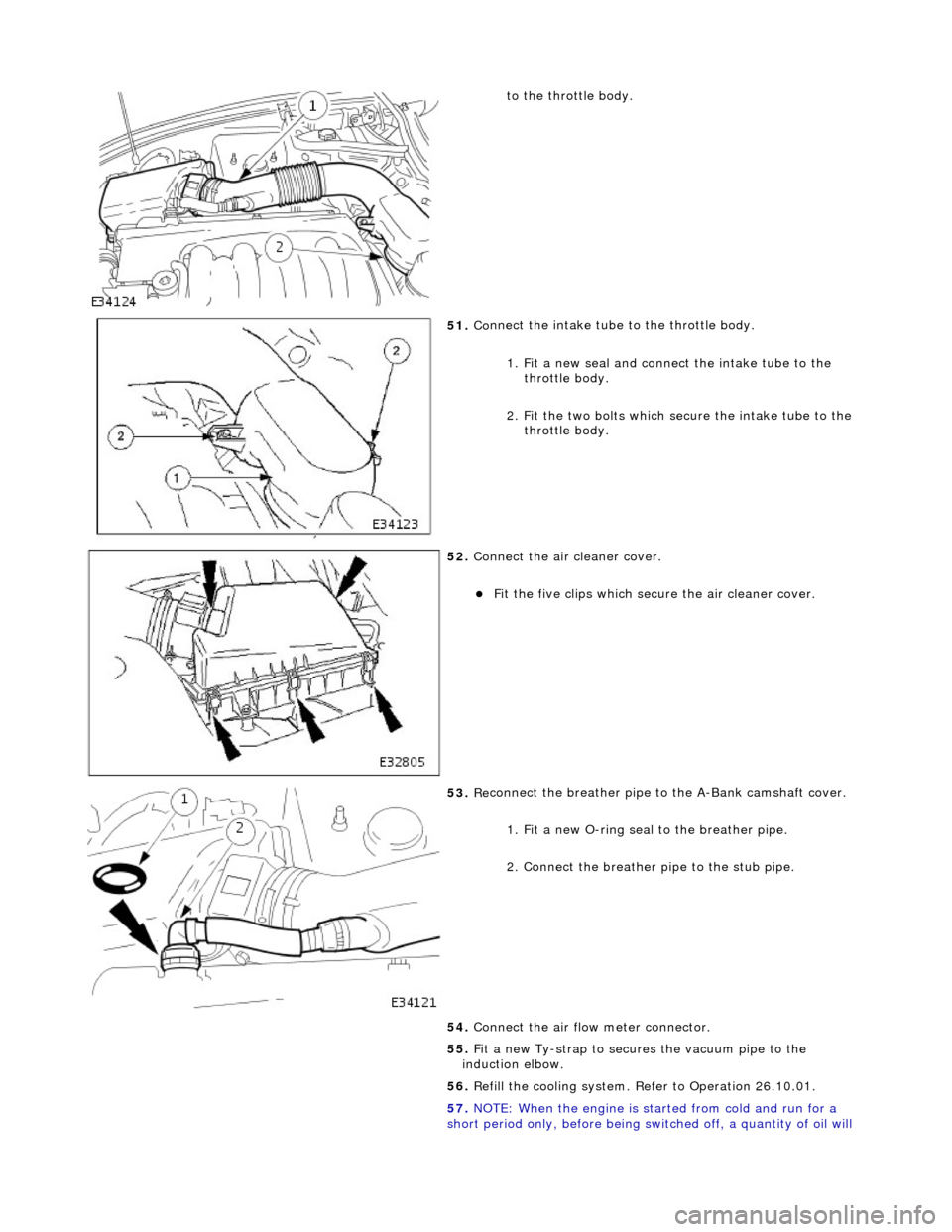
to th
e throttle body.
51 . Co
nnect the intake tube to the throttle body.
1. Fit a new seal and connect the intake tube to the throttle body.
2. Fit the two bolts which secure the intake tube to the throttle body.
52 . Conne
ct the air cleaner cover.
F
it
the five clips which secu
re the air cleaner cover.
53 . Re
connect the breather pipe to the A-Bank camshaft cover.
1. Fit a new O-ring seal to the breather pipe.
2. Connect the breather pipe to the stub pipe.
54. Connect the air flow meter connector.
55. Fit a new Ty-strap to secures the vacuum pipe to the
induction elbow.
56. Refill the cooling system. Refer to Operation 26.10.01.
57. NOTE: When the engine is star ted from cold and run for a
short period only, before being swit ched off, a quantity of oil will
Page 924 of 2490
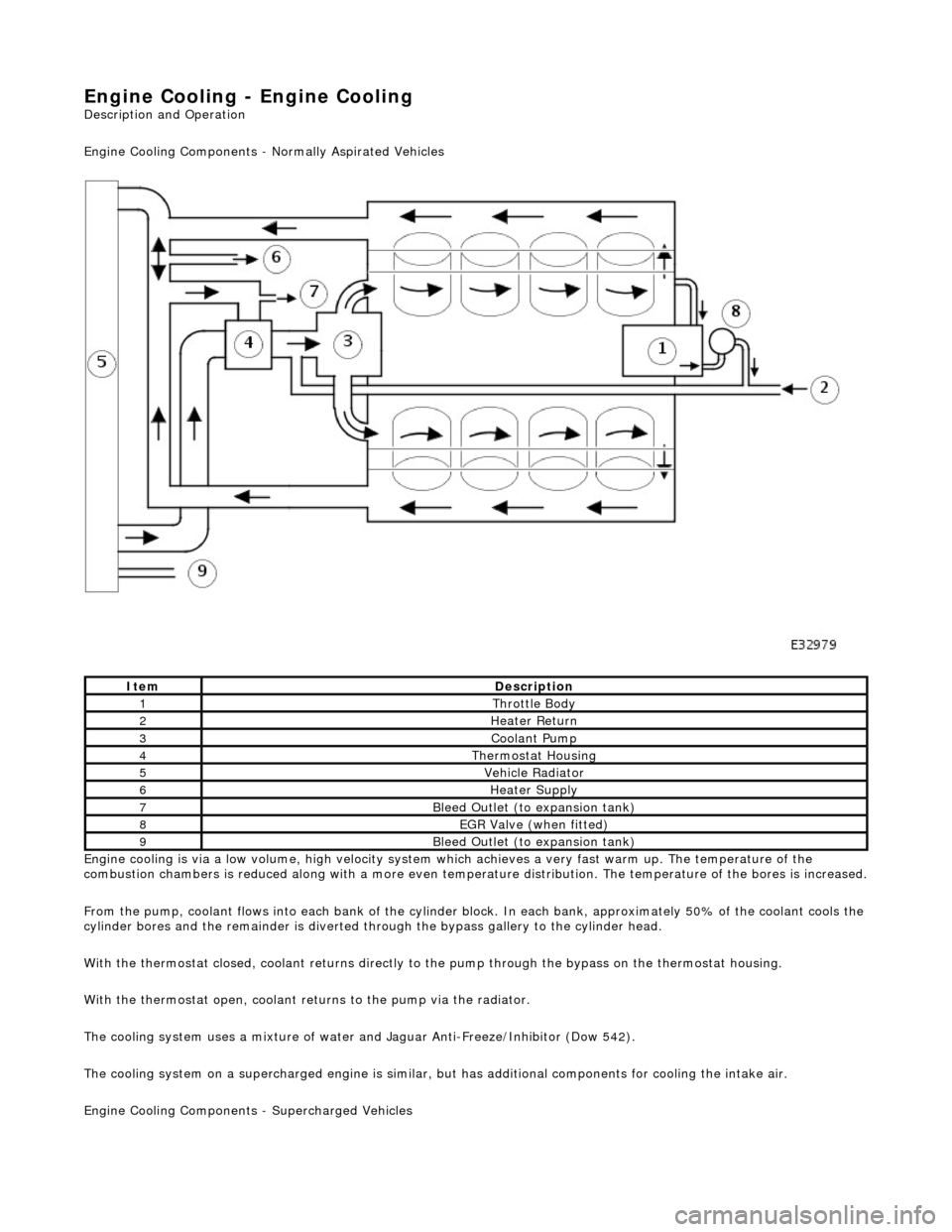
Engine Cooling
- Engine Cooling
Descr
i
ption and Operation
Engine Cooling Comp onents - Normally Aspirated Vehicles
Engine cooling is via a low volume, high velocity system which achieves a very fast warm up. The temperature of the
combustion chambers is reduced along with a more even temperature distribution. The temperature of the bores is increased.
F r
om the pump, coolant flows into each bank of the cylinder bl
ock. In each bank, approximately 50% of the coolant cools the
cylinder bores and the remainder is diverted th rough the bypass gallery to the cylinder head.
With the thermostat closed, coolant returns directly to the pump through the bypass on the thermostat housing.
With the thermostat open, coolant returns to the pump via the radiator.
The cooling system uses a mixture of water and Jaguar Anti-Freeze/Inhibitor (Dow 542).
The cooling system on a supercharged engine is similar, but has additional components for cooling the intake air.
Engine Cooling Co mponents - Supercharged Vehicles
ItemDescrip
tion
1Thr
ottle B
ody
2Hea
ter Return
3Coolant Pum p
4Ther
mostat Housing
5Vehicle Radia
t
or
6Hea
ter Su
pply
7Bleed
Outl
et (to expansion tank)
8EGR V
a
lve (when fitted)
9Bleed
Outl
et (to expansion tank)